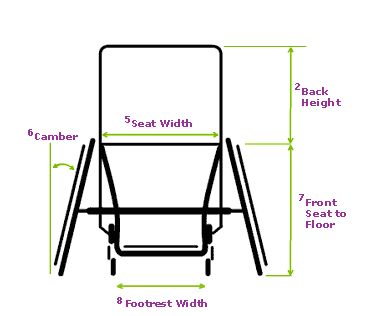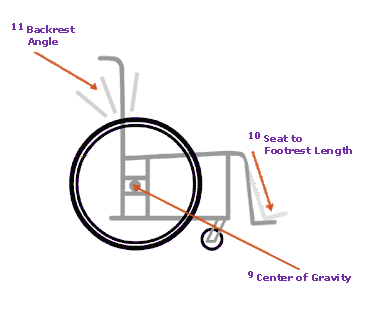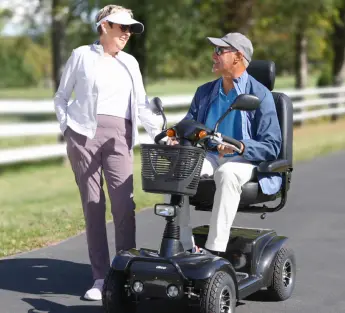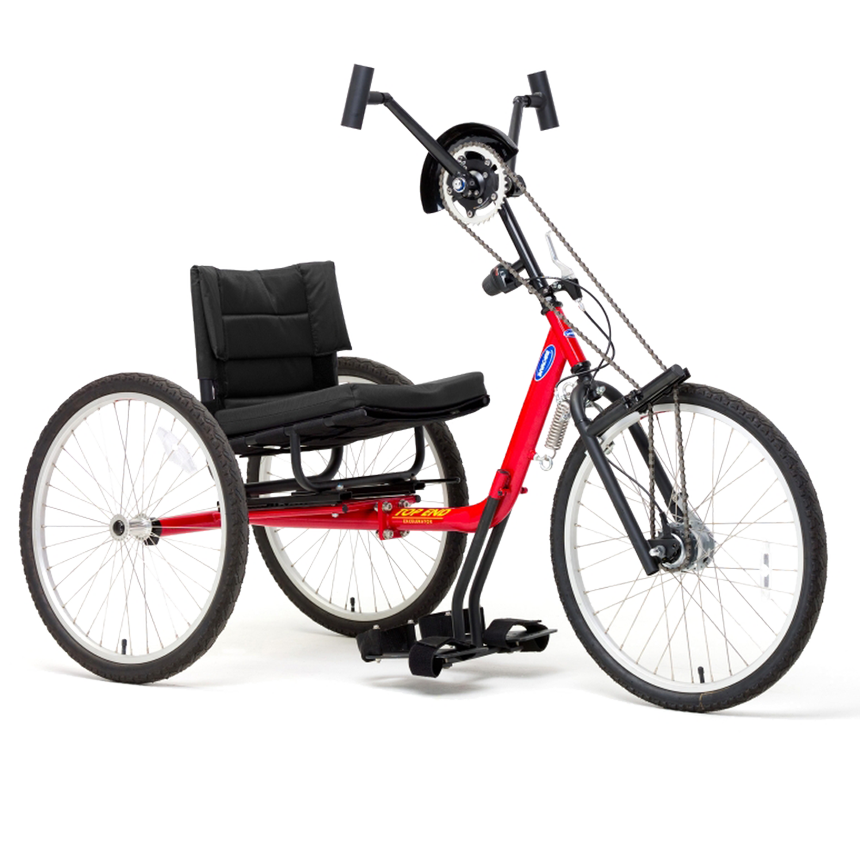Top End Excelerator Custom
7 seat sizes and a smooth ride custom fit for you



The SpinLife Difference Includes:
3 Year Limited Warranty
Made in the USA

Features
- Durable carbon steel oval tube frame.
- Adjustable fore and aft seat position makes transfers easier.
- Adjustable dual footrests and safety straps.
- Easy-to-reach 7-speed shifter.
- Ovalized ergonomic handles.
- Adjustable crank height.
- Adjustable tension upholstery.
- 24" performance wheels; cruiser tires.
- Cushion.
- Footrests are both height and angle adjustable.
- Powder coat paint.
Key Specs
- Quick-Release Axles: Yes
- Weight capacity: 350 lbs.
- Starting Weight: 50 lbs.
Manuals, Literature & Videos
Overview
If you want a great way to exercise, cross-train or just have fun, the Top End Excelerator handcycle is just what you're looking for. Extremely stable and maneuverable, the Top End Excelerator handcycle is capable of speeds up to 15 mph and can tackle hills or level terrain with equal ease.
• This upright and extremely maneuverable three-wheel handcycle is capable of speeds up to 15 mph.
• Smooth seven-speed Shimano® hub with its reversing drum brake delivers hands-on braking and allows the rider to tackle hills or level terrain with equal ease.
• Options include: the popular mountain drive, which adds 7 extra low gears for climbing hills or the V crankset option with its wider cranks to allow more clearance for those who are tall or require additional space.
If you are looking for a faster shipping model, check out the Top End Excelerator Quick Ship, it has many of the popular features of the Custom Excelerator, but ships from the warehouse in just one week.
Measuring Guide



- Seat Depth1
- Measure from the most posterior point of the body to the inside of the knee, minus at least two inches. Optimal contact between the legs and the seat increases stability for the body.
- Back Height2
- Measured from the seat base to the top of the chair back. Sport users need enough height for upper body support, yet low enough to allow the arms and trunk to rotate freely.
- Rear Seat to Floor3
- Measurement from the ground to the rear seat edge. Relative to the front seat-to-floor dimension, this determines the rearward slope ("dump" or "squeeze") of the seat. Sport chairs usually have more dump for extra upper body stability.
- Hanger Angle4
- Determines how far the toes extend away from the body, measured from the horizontal. Sport users often use very tight angles to be able to rotate in the smallest possible space.
- Seat Width5
- Determined by the widest point of the body from knee to hip, plus an inch to ensure room to move. Sport chairs are typically as narrow as possible to save weight which improves agility.
- Wheel Camber6
- Angle of the wheel relative to the vertical. More camber improves stability and agility, but also limits ability to pass through narrow spaces. A typical sport chair uses nine to twelve degrees of camber.
- Front Seat to Floor7
- Measure the leg from the back of the knee to the sole of the foot. Then subtract the thickness of the cushion when it is compressed. Next, add a minimum of two inches for footrest clearance. Do not add the footrest clearance if the chair will be foot-propelled.
- Footrest Width8
- Measure from the inside of each legrest tubing the distance or desired distance between legrests.
- Center of Gravity9
- Measure from the front of the seat back post to the center of the rear axel.
- Seat to Footrest Length10
- Measure from the edge of the seat upholstery to the top rear of the footrest.
- Backrest Angle11
- Measure the the angle of the back post to the floor. Ninety degrees will be perpendicular to the floor, to approximate the angle from the back post to the seat, subtract two degrees from measurment for every .5" of dump. Find a sport chair
More Information on the Top End Excelerator Custom
See also:
Specs
| Seat Widths: |
15" 16" 17" 18" 19" 20" |
| Product Weight: | 50 lbs. |
| Frame Type: | Rigid |
| Rear Wheel Size: | 24" |
| Quick-Release Axles: | Yes |
| Product Weight Range: | 30 lbs or more |
Approximate Shipping Dimensions and Weights
| Product Weight: | 50 lbs. |
| Box 1 | |
| Shipping Weight: | 40.00 lbs. |
| Length: | 48.00" |
| Width: | 36.00" |
| Height: | 34.00" |
Top End Excelerator Custom Reviews
100% of reviewers recommend this
These reviews are from SpinLife customers who have purchased and used the Top End Excelerator Custom.
Customer Reviews
Showing:
More Information on the Top End Excelerator Custom
See also:
Warranty Information
More Information on the Top End Excelerator Custom
See also:
Return Policy
This item is non-returnable for one of the following reasons:
- This item is custom-made by the manufacturer to suit your specific needs . Please review all specifications carefully before placing your order.
- Once production of your custom item has begun – the order is unable to be cancelled.
- For hygienic safety and per FDA regulations this item is non-returnable, even if unused.
- Once products are installed, the product is no longer returnable.
- Please inspect your product upon delivery. If the product is damaged or is not the correct product, please refuse the delivery. If your item was delivered without a signature and is damaged or incorrect please call SpinLife Customer Service.
If you have questions about this item please call a SpinLife Expert at 1-800-850-0335.
More Information on the Top End Excelerator Custom
See also:





 Contact Us
Contact Us
 M-F 9am - 6pm ET
M-F 9am - 6pm ET
 Request parts
Request parts Request Service
Request Service

